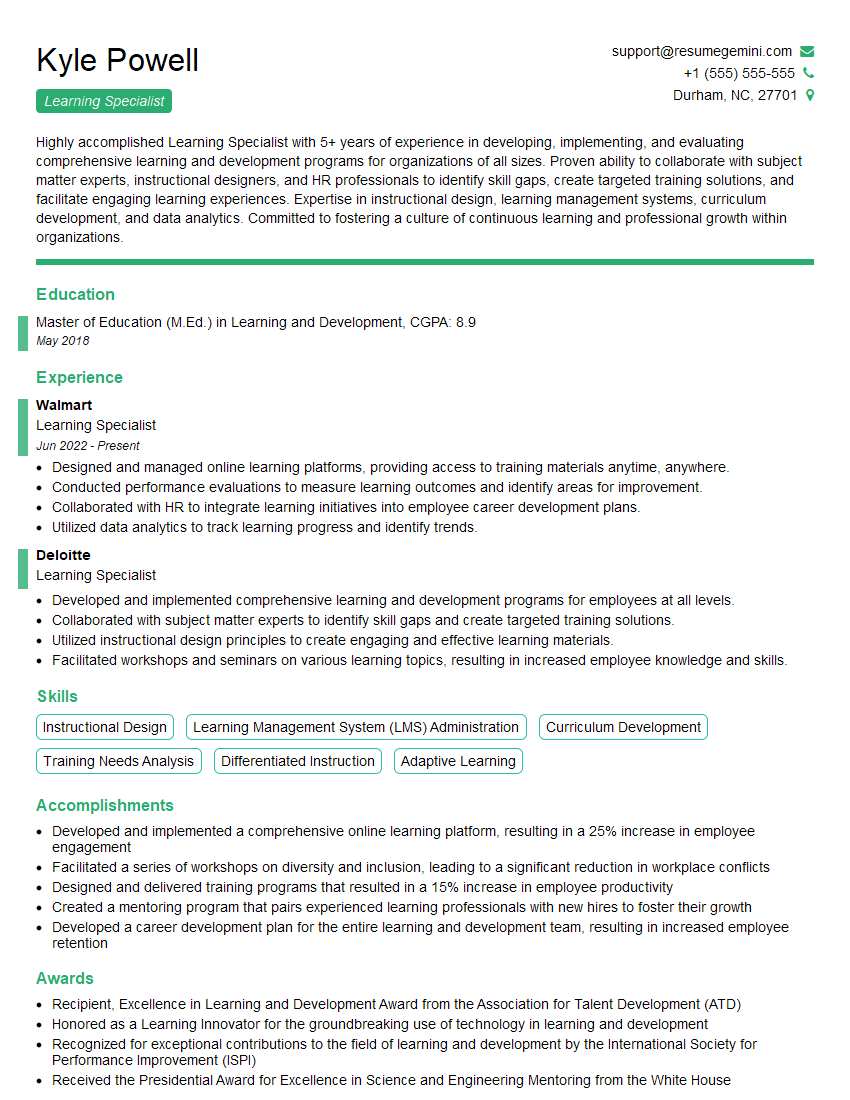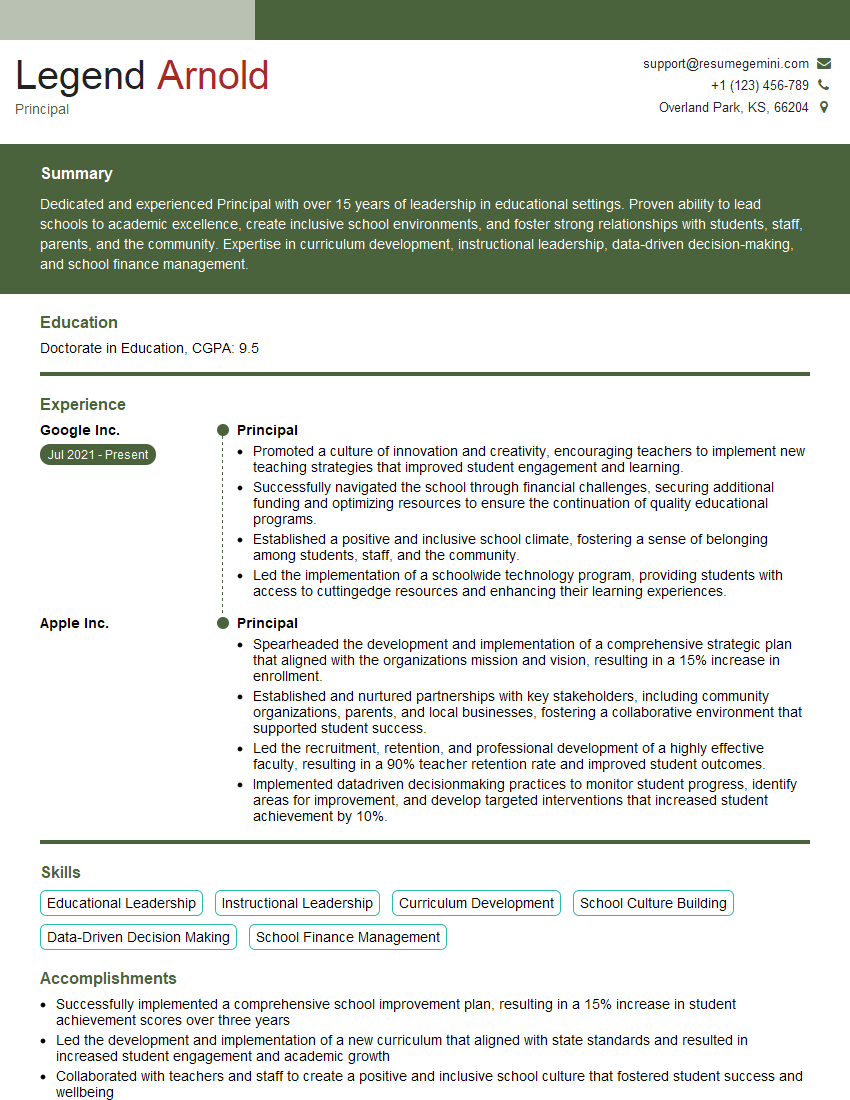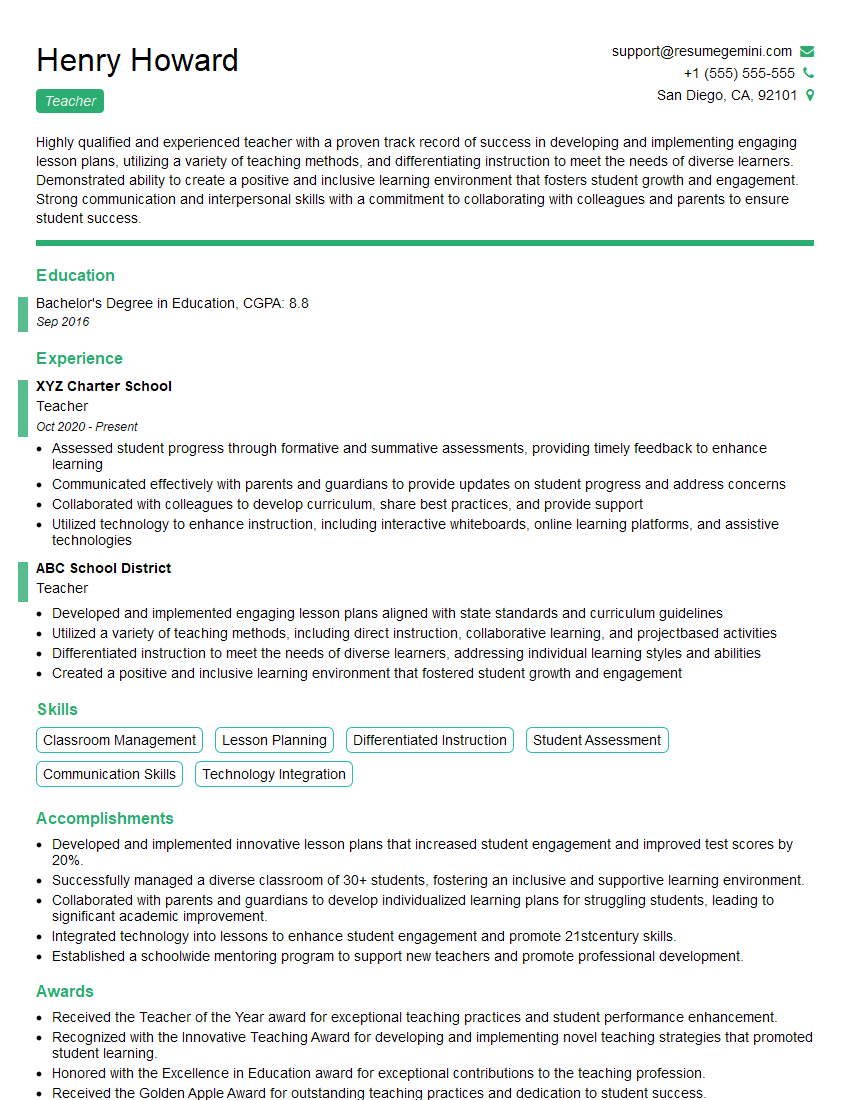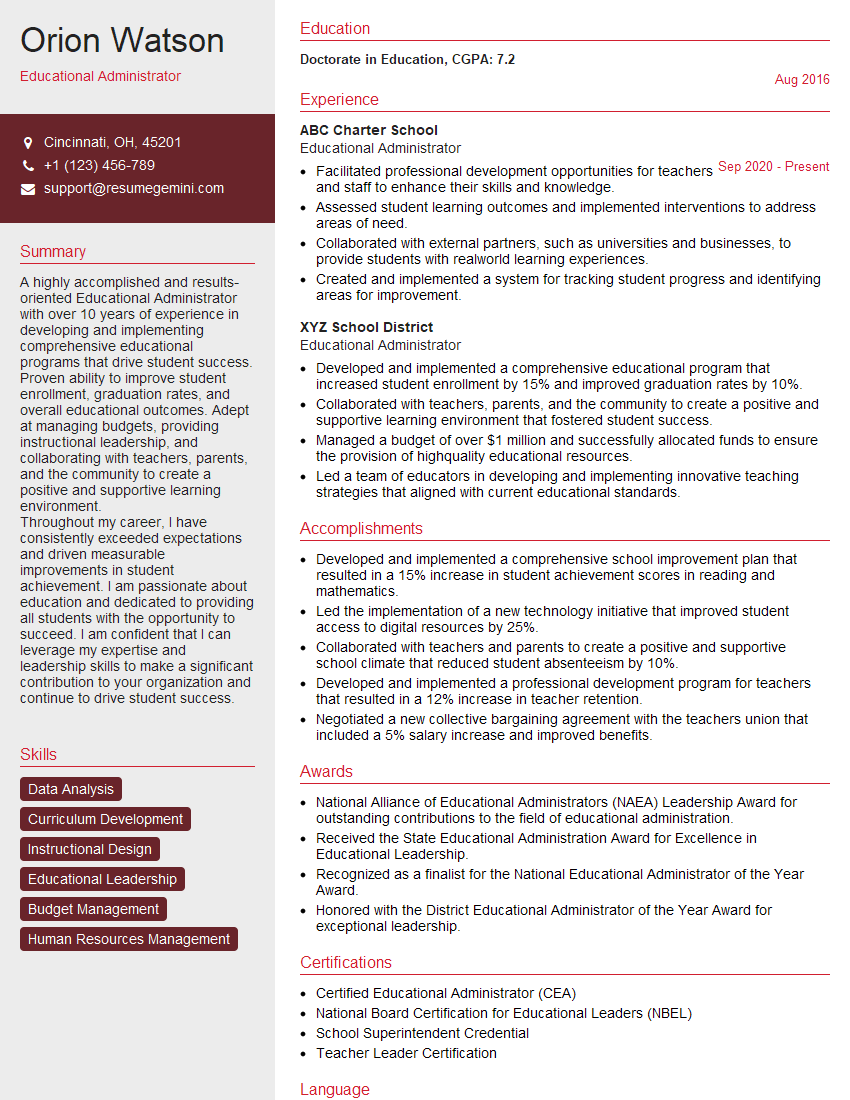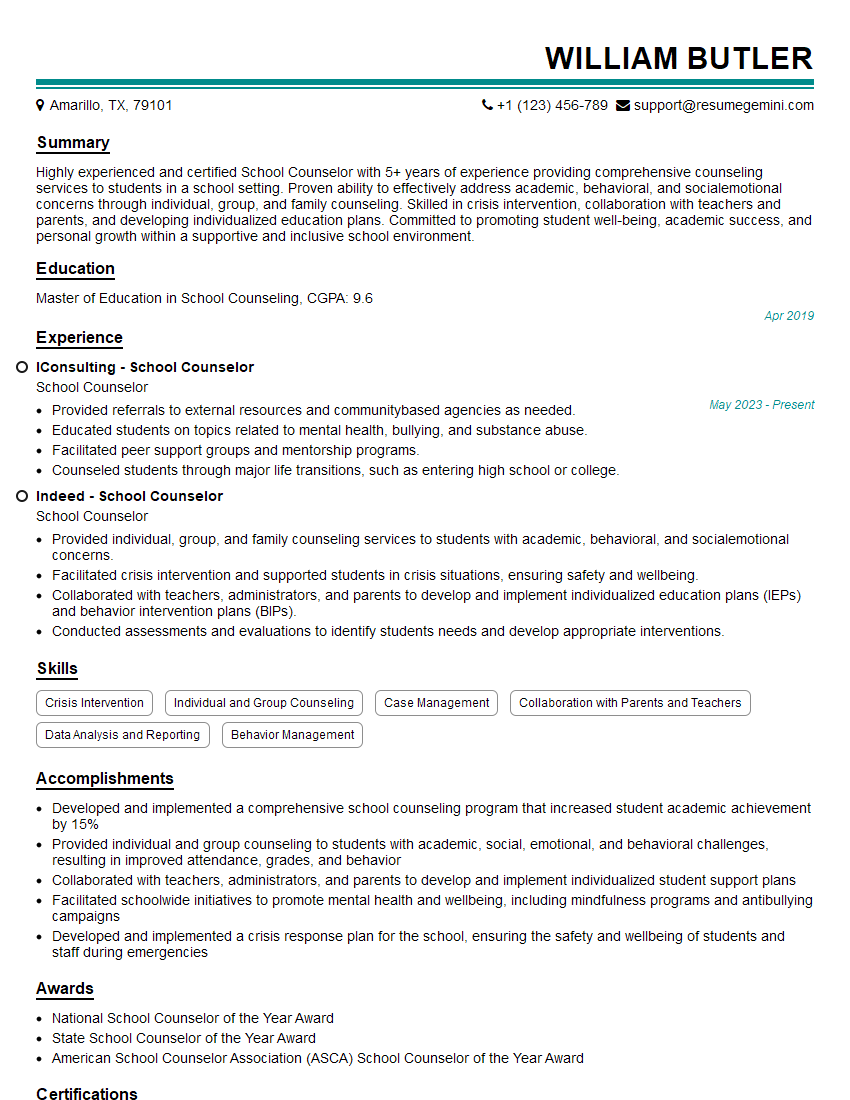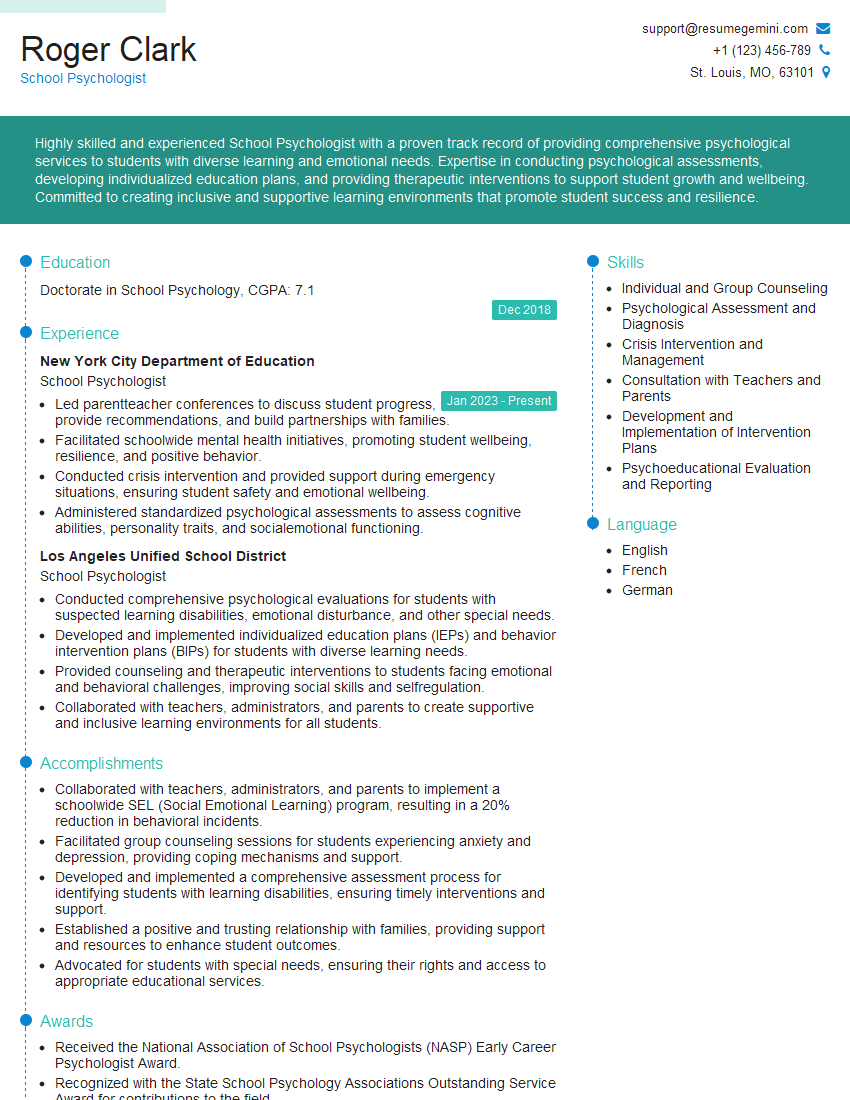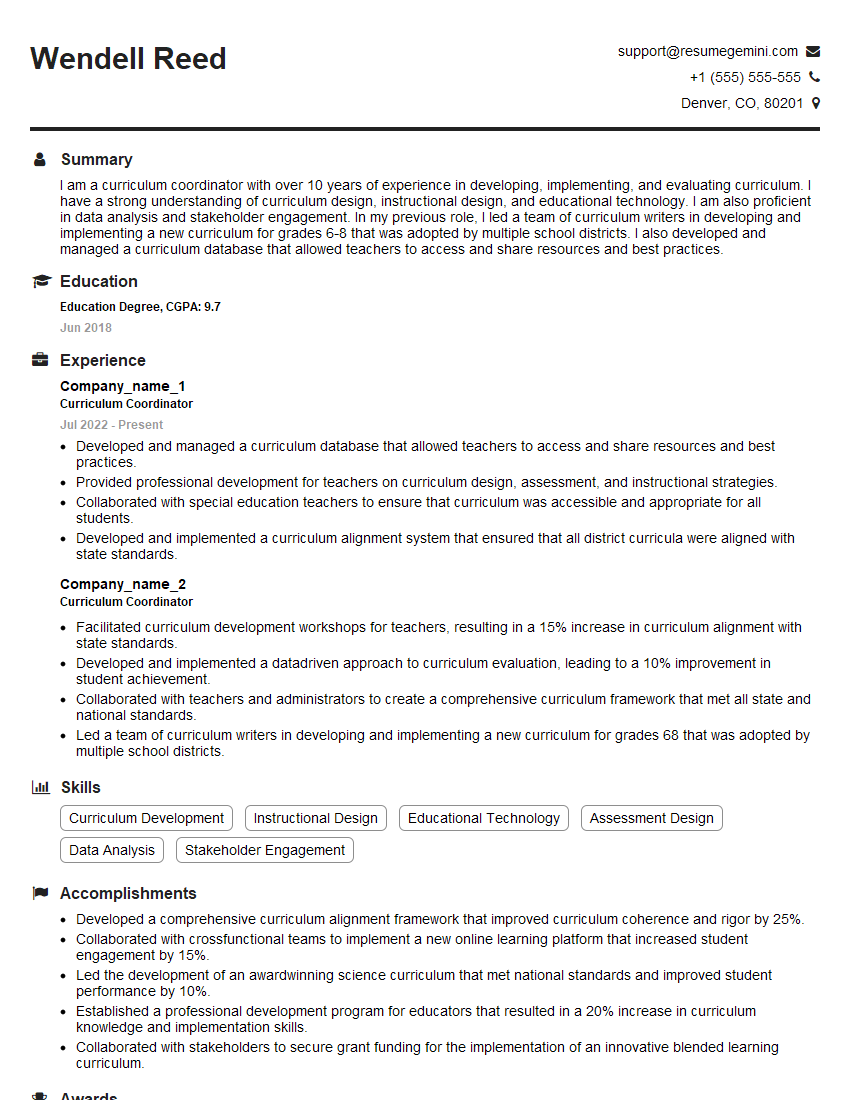Feeling uncertain about what to expect in your upcoming interview? We’ve got you covered! This blog highlights the most important Enhancing student engagement and motivation interview questions and provides actionable advice to help you stand out as the ideal candidate. Let’s pave the way for your success.
Questions Asked in Enhancing student engagement and motivation Interview
Q 1. Describe your experience designing engaging lesson plans.
Designing engaging lesson plans requires a deep understanding of learning styles and a commitment to active learning. My approach begins with clearly defining learning objectives, ensuring they’re aligned with curriculum standards and student needs. I then incorporate diverse teaching methods, moving beyond traditional lectures. I leverage storytelling, real-world examples, and hands-on activities to make learning relevant and memorable.
For instance, when teaching about the American Revolution, instead of just lecturing on key battles, I might incorporate a role-playing activity where students take on the roles of different historical figures, debating the causes and consequences of the war. This fosters critical thinking and active participation. Another example would be using a case study approach in a business class, allowing students to analyze real-world business problems and develop solutions. This makes the learning far more engaging than simply reading about theories.
- Variety of Activities: Incorporating group work, individual projects, presentations, debates, and games keeps students engaged and caters to different learning styles.
- Technology Integration: Interactive simulations, educational videos, and online quizzes can significantly boost student interest and understanding.
- Differentiation: Building in multiple pathways to demonstrate understanding ensures all students can participate successfully.
Q 2. Explain a time you successfully motivated a disengaged student.
I once had a student, let’s call him Michael, who was consistently disengaged in my history class. He seemed disinterested and often disruptive. After observing him for a few weeks, I realized he wasn’t necessarily struggling academically but lacked a connection to the material. I initiated a one-on-one conversation with him, discovering he was passionate about video game design.
I adapted my teaching strategy. I incorporated a project where students could design a historical video game, allowing them to creatively express their understanding of the historical period. Michael thrived. He became highly engaged, researching historical details meticulously to make his game authentic. He not only completed the project successfully but also began participating more actively in class discussions, demonstrating a renewed interest in the subject. This highlighted the importance of understanding individual student interests and tailoring instruction accordingly.
Q 3. What strategies do you use to differentiate instruction for diverse learners?
Differentiation is crucial for maximizing student learning in diverse classrooms. My strategies focus on providing varied learning experiences catering to different learning styles, readiness levels, and interests. I use a tiered assignment approach, offering variations of the same task at different levels of complexity. This ensures all students are challenged appropriately.
For example, in a math class, I might offer three versions of a problem-solving assignment: a simpler version for students who need more support, a standard version for those working at grade level, and a more challenging version for advanced learners. I also utilize flexible grouping strategies, pairing students with diverse skill sets for collaborative projects, promoting peer learning and support.
- Multiple Representations: Providing information through various formats, such as visual aids, audio recordings, and textual descriptions.
- Choice Boards: Offering students a menu of activities from which they can choose, allowing them to work on tasks that align with their learning preferences.
- Adjusted Pacing: Allowing students to work at their own pace, providing extra time and support when needed.
Q 4. How do you assess student understanding and adjust your teaching accordingly?
Assessing student understanding is an ongoing process, not a single event. I employ a variety of formative assessment techniques throughout the learning process to gauge student progress and adjust my teaching accordingly. These include:
- Exit Tickets: Brief questions at the end of class to check for immediate understanding.
- Quick Quizzes: Short, informal quizzes to assess comprehension of key concepts.
- Observations: Paying attention to student participation, engagement, and understanding during lessons.
- Discussions: Encouraging classroom discussions to uncover misconceptions and clarify understanding.
- Summative Assessments: Larger-scale assessments, such as tests and projects, to evaluate overall learning.
Based on this data, I modify my instruction to address areas where students are struggling, reinforce key concepts, and provide additional support where needed. This iterative process ensures that teaching is responsive to student learning needs.
Q 5. What technology tools have you used to enhance student engagement?
Technology plays a vital role in enhancing student engagement. I have utilized several tools to create a dynamic and interactive learning environment. For example:
- Interactive Whiteboards: To present lessons visually, incorporating multimedia elements and interactive activities.
- Educational Software and Apps: Such as Kahoot!, Quizizz, and educational games, to make learning fun and competitive.
- Learning Management Systems (LMS): Such as Canvas or Moodle, to deliver course content, assign tasks, and facilitate communication with students.
- Online Collaboration Tools: Such as Google Docs or Microsoft Teams, to facilitate group projects and peer learning.
- Virtual Reality (VR) and Augmented Reality (AR) applications: To create immersive learning experiences.
The choice of technology depends on the specific learning objectives and the needs of the students. The key is to integrate technology thoughtfully, ensuring it supports and enhances learning rather than merely replacing traditional methods.
Q 6. How do you foster a positive and inclusive classroom environment?
Fostering a positive and inclusive classroom environment is paramount. I believe in creating a space where all students feel respected, valued, and safe to participate. This involves:
- Establishing Clear Expectations: Communicating classroom rules and procedures clearly from the beginning.
- Building Relationships: Getting to know students individually, understanding their strengths, challenges, and interests.
- Promoting Respectful Communication: Teaching students how to communicate respectfully with each other and with me.
- Celebrating Diversity: Creating a classroom that values and celebrates the diverse backgrounds and perspectives of all students.
- Providing Opportunities for Collaboration: Encouraging teamwork and peer support.
- Addressing Bullying and Harassment Promptly and Effectively: Creating a zero-tolerance policy for such behaviors.
By creating a sense of community and belonging, I aim to empower students to take ownership of their learning and feel confident in expressing themselves.
Q 7. Describe your approach to providing constructive feedback to students.
Providing constructive feedback is crucial for student growth. My approach focuses on providing specific, actionable feedback that helps students understand their strengths and areas for improvement. I avoid generic comments and instead focus on specific examples from their work.
For instance, instead of saying “Good job!,” I might say, “Your introduction clearly stated the main points of your essay, however, the conclusion could be strengthened by summarizing those points more effectively and adding a concise concluding statement.” I also focus on providing both positive and constructive feedback, highlighting what the student did well while suggesting ways to improve. I frame feedback as an opportunity for growth and learning, aiming to encourage perseverance and build students’ confidence.
- Specific and Actionable: Providing concrete examples of what the student did well and areas for improvement.
- Balanced: Highlighting both strengths and areas for growth.
- Focus on the Work, Not the Person: Offering feedback that focuses on the student’s work, rather than making personal judgments.
- Encouraging and Supportive: Providing feedback in a way that is encouraging and supportive, promoting a growth mindset.
Q 8. How do you incorporate student interests into your curriculum?
Incorporating student interests is crucial for boosting engagement. It’s about connecting the curriculum to their passions, making learning relevant and motivating. I achieve this through several strategies:
Pre-assessment surveys and discussions: I begin by understanding their interests through surveys, informal chats, and brainstorming sessions. This helps me gauge their existing knowledge and identify topics they’re genuinely curious about.
Project-based learning: I design projects that allow students to explore topics within their interest areas. For example, if a class is studying the Roman Empire, students passionate about art can focus on Roman architecture, while those interested in politics can delve into the Roman Senate.
Choice and autonomy: Whenever feasible, I offer choices within assignments and assessments. This might involve selecting a research topic, choosing a presentation format, or deciding on the medium for expressing their understanding (e.g., essay, video, presentation).
Real-world connections: I actively link curriculum content to real-world applications. This could involve guest speakers, field trips, or integrating current events into discussions. For instance, discussing current environmental issues while teaching ecology makes the subject more relatable.
For instance, in a history class, instead of solely focusing on dates and battles, I incorporated a project where students researched and presented on historical figures who inspired them. The results were remarkable; students showed increased engagement and deeper understanding.
Q 9. What methods do you use to promote collaboration and teamwork among students?
Collaboration and teamwork are essential for 21st-century skills development. I utilize various methods to foster a positive collaborative environment:
Structured group activities: I design activities requiring students to work together towards a common goal. This might involve collaborative problem-solving tasks, group research projects, or peer teaching sessions.
Think-Pair-Share: This simple strategy encourages students to reflect individually before discussing their ideas with a partner and then sharing with the larger group. It’s a great way to get everyone involved and build confidence.
Peer assessment: Involving students in the evaluation process encourages them to understand different perspectives and contribute to a supportive learning environment. Providing clear rubrics helps guide this process effectively.
Team-based projects with defined roles: Assigning specific roles within group projects ensures each member contributes meaningfully and develops different skills. This could involve roles such as researcher, presenter, editor, etc.
Positive group dynamics: I explicitly teach students about effective teamwork, including communication strategies, conflict resolution techniques, and the importance of mutual respect. I also emphasize celebrating collective successes.
For example, in a science class, students collaborated on building and testing a model bridge, learning about structural engineering principles while developing teamwork and problem-solving skills.
Q 10. How do you address challenging behaviors that disrupt learning?
Addressing challenging behaviors requires a proactive and multi-faceted approach. My strategy involves:
Positive behavior interventions and supports (PBIS): I focus on establishing clear expectations and consistently reinforcing positive behaviors. This creates a positive classroom culture where disruptive behaviors are less likely to occur.
Individualized strategies: I work to understand the root causes of challenging behaviors, which might involve talking to the student, observing their interactions, or consulting with colleagues or specialists.
Consistent and fair discipline: When disruptive behaviors occur, I address them consistently and fairly, using restorative justice principles whenever possible. This focuses on repairing harm and teaching students responsibility for their actions.
Collaboration with parents/guardians: Maintaining open communication with parents/guardians is crucial. I involve them in developing strategies to support the student’s success both at school and at home.
Seeking support when needed: I don’t hesitate to seek guidance from school counselors, administrators, or specialists when needed. This ensures the student receives appropriate interventions.
For instance, I once had a student who consistently interrupted class. After talking to him and observing his behavior, I realized he was struggling with attention and needed more structure and engagement. We developed a personalized learning plan, and his behavior significantly improved.
Q 11. Explain your understanding of different learning styles and how you cater to them.
Understanding different learning styles is critical for effective teaching. While the idea of distinct learning styles (visual, auditory, kinesthetic) is debated, catering to diverse learning preferences is crucial. My approach focuses on:
Multimodal instruction: I use a variety of teaching methods to cater to various learning preferences. This includes visual aids, auditory explanations, hands-on activities, and interactive discussions.
Differentiated instruction: I adapt my teaching materials and activities to meet the needs of individual students. This might involve providing different levels of support, using varied assessment methods, or offering choices in assignments.
Flexibility and choice: I provide opportunities for students to learn in ways that best suit them. This might include allowing students to work independently, collaboratively, or in small groups.
Student self-assessment: I encourage students to reflect on their learning preferences and identify strategies that work best for them.
For example, when teaching a math concept, I might provide visual diagrams, explain the concept verbally, and then have students work through hands-on problems. This allows students with different learning preferences to engage with the material effectively.
Q 12. How do you use formative and summative assessment to track student progress?
Formative and summative assessments are both essential for tracking student progress. Formative assessments are ongoing evaluations that provide feedback during the learning process, while summative assessments offer a final evaluation of learning.
Formative assessment examples: These include quizzes, exit tickets, class discussions, observations, and informal check-ins. The feedback from these assessments helps me adjust my teaching and provide targeted support to students.
Summative assessment examples: These include tests, exams, projects, and presentations. These offer a comprehensive view of student learning at the end of a unit or course.
Using data for improvement: I analyze data from both formative and summative assessments to identify areas where students are excelling and areas where they need more support. This data informs my instruction and helps me personalize learning experiences.
For example, after a formative quiz showing that many students struggled with a particular concept, I adjusted my lesson plan to provide additional practice and support before the summative exam.
Q 13. Describe a time you had to adapt your teaching methods due to unexpected challenges.
During a unit on Shakespeare, a severe snowstorm unexpectedly closed the school for several days. Initially, I was concerned about the disruption to my lesson plan. However, I adapted by creating online learning modules using accessible digital resources. I utilized online platforms to deliver video lectures, provide interactive exercises, and facilitate virtual discussions. Students were given assignments that could be completed independently or collaboratively online.
This unexpected challenge forced me to develop my technological skills and embrace a more flexible approach to teaching. While I missed the in-person interaction, the experience proved that with the right tools and planning, impactful learning can continue even during unforeseen circumstances. The online modules proved successful, and students even reported enjoying the different learning format. It was a valuable lesson in adaptability and the importance of being prepared for unexpected disruptions.
Q 14. How do you build rapport with students and create a strong teacher-student relationship?
Building rapport and strong teacher-student relationships is fundamental for effective teaching and student success. My approach involves:
Creating a welcoming classroom environment: I strive to create a classroom that is inclusive, respectful, and supportive. I get to know my students individually, learning about their interests and backgrounds.
Active listening and empathy: I actively listen to my students and show empathy for their experiences and challenges. This involves creating opportunities for open communication and making myself accessible.
Positive reinforcement and encouragement: I regularly offer positive reinforcement and encouragement, celebrating both individual and collective achievements. This boosts students’ confidence and fosters a sense of belonging.
Fairness and consistency: I treat all students fairly and consistently, demonstrating respect for their individual differences. This builds trust and fosters a sense of equity.
Open communication: I maintain open communication with students, providing regular feedback and creating opportunities for them to share their thoughts and concerns.
For example, I regularly have informal chats with students during break times or after class to get to know them better and build a friendly relationship. I believe that when students feel seen and understood, they are more likely to engage actively in learning.
Q 15. What strategies do you employ to promote self-directed learning in students?
Promoting self-directed learning empowers students to take ownership of their education. It’s about fostering intrinsic motivation rather than relying solely on external rewards. I achieve this through several key strategies:
Choice and Autonomy: Offering students choices in their assignments, projects, or learning materials significantly increases engagement. For instance, I might provide a list of research topics related to a unit, allowing students to select one that genuinely interests them. This fosters a sense of ownership and responsibility.
Goal Setting and Reflection: I guide students in setting personal learning goals, using SMART goals (Specific, Measurable, Achievable, Relevant, Time-bound) as a framework. Regular reflection exercises, through journaling or discussions, help them track their progress and identify areas for improvement. This process makes learning more tangible and encourages self-assessment.
Inquiry-Based Learning: Instead of directly lecturing, I pose open-ended questions and encourage students to explore answers through research and collaboration. This approach transforms them from passive recipients of information into active learners, driving their own investigation.
Providing Resources and Support: Self-directed learning doesn’t mean students are left alone. I provide a range of resources, including online tutorials, library access, and mentorship opportunities. Regular check-ins ensure students stay on track and receive necessary guidance.
Career Expert Tips:
- Ace those interviews! Prepare effectively by reviewing the Top 50 Most Common Interview Questions on ResumeGemini.
- Navigate your job search with confidence! Explore a wide range of Career Tips on ResumeGemini. Learn about common challenges and recommendations to overcome them.
- Craft the perfect resume! Master the Art of Resume Writing with ResumeGemini’s guide. Showcase your unique qualifications and achievements effectively.
- Don’t miss out on holiday savings! Build your dream resume with ResumeGemini’s ATS optimized templates.
Q 16. How do you encourage student participation and active learning in the classroom?
Encouraging active learning transforms the classroom from a passive lecture hall into a dynamic environment where students are actively involved in the learning process. I achieve this by:
Think-Pair-Share: This simple yet effective technique involves posing a question, giving students time to think individually, discussing with a partner, and then sharing their thoughts with the larger group. It encourages participation from even the quietest students.
Interactive Games and Activities: Incorporating games and activities related to the subject matter makes learning fun and engaging. For example, using Kahoot! for quizzes or creating a classroom debate can significantly boost participation.
Collaborative Projects: Group projects necessitate teamwork and communication, encouraging active participation and shared responsibility. I carefully structure these projects to ensure equitable contribution from all group members.
Utilizing Technology: Interactive whiteboards, educational apps, and online forums can be powerful tools for engaging students in dynamic learning experiences. For example, using online polling tools allows for real-time feedback and participation.
Creating a Safe and Supportive Classroom Environment: Students are more likely to participate if they feel comfortable and respected. Fostering a classroom culture that values diverse perspectives and encourages open dialogue is crucial.
Q 17. What are some effective techniques for managing student behavior?
Managing student behavior effectively requires a proactive and positive approach that focuses on prevention and building positive relationships. My strategies include:
Establishing Clear Expectations and Rules: At the beginning of the year, I collaboratively create a classroom code of conduct with students. This process ensures they understand the expectations and feel a sense of ownership.
Positive Reinforcement: I regularly praise and reward positive behaviors, focusing on what students are doing well. This approach is far more effective than constantly reprimanding negative behaviors.
Restorative Practices: When misbehavior occurs, I focus on repairing harm and restoring relationships rather than simply punishing the student. This approach helps students understand the impact of their actions and learn from their mistakes.
Individualized Support: I recognize that each student is unique and may have different needs. I work closely with students who consistently struggle with behavior, providing individualized support and strategies tailored to their specific challenges.
Collaboration with Parents and Administration: When necessary, I collaborate closely with parents and school administrators to address persistent behavior issues. Open communication is key to finding effective solutions.
Q 18. How do you use data to inform your instructional decisions?
Data-driven instruction allows me to make informed decisions that enhance student learning. I use various data sources to inform my teaching:
Formative Assessments: Regular quizzes, exit tickets, and class discussions provide ongoing feedback on student understanding, allowing me to adjust my instruction in real-time.
Summative Assessments: Tests, projects, and presentations provide a comprehensive picture of student learning at the end of a unit or course. This data helps me identify areas where students need additional support.
Student Work Samples: Reviewing student work helps me understand their strengths and weaknesses, identify patterns in their errors, and tailor future instruction.
Attendance and Engagement Data: Tracking attendance and student participation in class activities provides insights into potential barriers to learning. For example, consistent absences might indicate a need for additional support or communication with the family.
Data Analysis and Reflection: I regularly analyze the data collected, reflecting on its implications for my teaching practices. This iterative process ensures that my instruction is constantly evolving to meet the needs of my students.
Q 19. Describe your experience with incorporating project-based learning into your teaching.
Project-based learning (PBL) is a powerful pedagogical approach that fosters deep understanding and engagement. My experience with PBL includes:
Designing Relevant Projects: I design projects that are aligned with curriculum standards and relevant to students’ lives and interests. For example, in a science class, students might design and conduct an experiment to solve a real-world problem.
Scaffolding the Learning Process: I provide students with clear guidelines, rubrics, and support throughout the project. This ensures that they have the resources and guidance they need to succeed.
Encouraging Collaboration and Teamwork: PBL projects often involve collaborative work, teaching students valuable teamwork and communication skills.
Providing Opportunities for Presentation and Sharing: Students present their projects to the class, sharing their findings and learning with their peers. This reinforces learning and enhances communication skills.
Assessing Learning Outcomes: I utilize a variety of assessment methods to evaluate student learning, including presentations, written reports, and peer feedback.
For example, in a history class, students recently completed a PBL project where they researched and created a museum exhibit on a significant historical event. This project allowed them to delve deeply into the topic, develop research skills, and learn about museum curation.
Q 20. How do you communicate effectively with parents/guardians about student progress?
Effective communication with parents/guardians is crucial for student success. I maintain open communication through:
Regular Communication: I use a variety of methods to communicate with parents, including email, newsletters, parent-teacher conferences, and progress reports. I make sure to share both positive and constructive feedback.
Positive and Proactive Communication: I proactively communicate with parents about student successes and challenges. This ensures that parents are informed and involved in their child’s education.
Parent-Teacher Conferences: I conduct regular parent-teacher conferences to discuss student progress, address concerns, and collaborate on strategies to support student learning.
Utilizing Technology: I use online platforms such as learning management systems (LMS) to share assignments, grades, and announcements with parents.
Active Listening and Empathy: I listen attentively to parents’ concerns and perspectives, showing empathy and understanding. This fosters a strong collaborative relationship.
Q 21. What professional development activities have you undertaken to enhance your skills in student engagement and motivation?
I am committed to continuous professional development to enhance my skills in student engagement and motivation. My recent professional development activities include:
Workshops on Differentiated Instruction: I participated in workshops focused on designing and delivering instruction that caters to the diverse learning needs and styles of my students. This has significantly improved my ability to engage students with varied learning preferences.
Training on Positive Behavior Interventions and Supports (PBIS): This training provided me with effective strategies for creating a positive and supportive classroom environment and managing student behavior proactively.
Conferences on Educational Technology: I regularly attend conferences and workshops on educational technology, staying current on innovative tools and strategies for engaging students.
Mentorship Program: I actively participate in a mentorship program, collaborating with experienced educators to learn best practices and refine my teaching strategies. This has provided invaluable feedback and guidance.
Independent Study: I dedicate time for independent study, researching new teaching methods and pedagogical approaches to enhance student engagement and motivation. I actively seek out resources and publications in the field of educational psychology.
Q 22. How do you address student anxiety and stress in the classroom?
Addressing student anxiety and stress requires a multifaceted approach focusing on creating a safe, supportive, and predictable classroom environment. It’s crucial to understand that anxiety manifests differently in each student; some might be outwardly disruptive, while others might withdraw. My strategy begins with proactive measures.
Building Relationships: I prioritize getting to know each student individually, understanding their strengths, challenges, and learning styles. This fosters trust and open communication, making it easier for them to share their concerns.
Clear Expectations and Routines: Consistent routines and clear expectations minimize uncertainty, a significant anxiety trigger. Students thrive in environments where they know what to expect.
Mindfulness and Stress-Reduction Techniques: I incorporate short mindfulness exercises, deep breathing techniques, or even guided imagery into the daily routine. These help students regulate their emotions and manage stress in the moment. For example, we might take a few minutes to practice mindful breathing before a challenging test.
Creating Opportunities for Success: Breaking down complex tasks into smaller, manageable steps helps students experience a sense of accomplishment, boosting confidence and reducing anxiety. Providing frequent positive feedback also reinforces their efforts.
Collaboration and Peer Support: Encouraging peer support and group work creates a sense of community and shared experience. Students can learn from and support each other, reducing feelings of isolation.
Open Communication with Parents/Guardians: Maintaining regular communication with parents/guardians allows for a collaborative approach to addressing anxiety concerns. Early intervention is crucial.
In cases of severe anxiety, I collaborate with school counselors and other support staff to provide additional resources and support for the student.
Q 23. Describe your experience with using technology to enhance student engagement in online learning environments.
Technology offers incredible potential for enhancing student engagement in online learning, particularly when used strategically and thoughtfully. My experience includes leveraging various tools to create interactive and stimulating online environments.
Interactive Platforms: I utilize platforms like Kahoot!, Quizizz, and Nearpod to transform traditional quizzes and assessments into engaging games. These interactive elements significantly increase student participation and enjoyment.
Collaborative Tools: Google Docs, Slides, and Jamboard facilitate real-time collaborative projects, allowing students to work together on assignments, share ideas, and provide feedback. This promotes a sense of community and shared learning.
Multimedia Resources: Incorporating videos, podcasts, and interactive simulations enriches the learning experience and caters to diverse learning styles. Visual and auditory learners benefit significantly from this approach.
Virtual Field Trips: I’ve used virtual reality or 360° videos to take students on virtual field trips, making learning more immersive and exciting. This is particularly effective for subjects like history, geography, or science.
Personalized Learning Platforms: I have explored adaptive learning platforms that adjust to individual student’s pace and learning needs, providing personalized feedback and support. This ensures that every student is challenged appropriately and receives the support they need.
However, it’s important to ensure equitable access to technology and to provide adequate training and support to both students and teachers. Technology is a tool; its effectiveness depends on how it’s integrated into the curriculum.
Q 24. How do you create a classroom culture that values effort, perseverance, and growth mindset?
Cultivating a classroom culture that values effort, perseverance, and a growth mindset is paramount for student success. It involves shifting the focus from innate ability to the process of learning.
Growth Mindset Language: I consciously use language that emphasizes effort and learning from mistakes. Instead of saying, “You’re so smart!,” I might say, “I’m impressed by your perseverance in tackling that challenging problem.” This subtly reinforces the value of effort.
Celebrating Effort and Progress: Publicly acknowledging and celebrating effort, even when the outcome isn’t perfect, sends a powerful message. I regularly highlight students’ perseverance and progress, regardless of their initial ability level.
Providing Feedback Focused on Effort and Strategy: My feedback focuses not only on the final product but also on the student’s approach and strategies. I encourage self-reflection and encourage students to analyze their learning process.
Embracing Mistakes as Learning Opportunities: Mistakes are viewed as valuable learning experiences. We analyze errors together, discuss strategies for improvement, and use them as springboards for growth.
Modeling a Growth Mindset: I model a growth mindset myself, openly sharing my own struggles and learning experiences. This shows students that it’s okay to struggle and that learning is an ongoing process.
By consistently reinforcing these values, I create a classroom environment where students feel safe to take risks, embrace challenges, and view setbacks as opportunities for growth.
Q 25. What are some common misconceptions about student motivation, and how do you address them?
Several misconceptions about student motivation hinder effective teaching. Addressing these misconceptions requires a shift in perspective.
Misconception 1: Motivation is Innate: Many believe that motivation is an inherent trait. The reality is that motivation is largely influenced by the learning environment and the teaching strategies employed. By creating engaging lessons and providing relevant and meaningful tasks, we can greatly impact students’ motivation.
Misconception 2: Rewards are the Only Motivators: While rewards can provide short-term boosts, relying solely on external rewards undermines intrinsic motivation. Focus should be on making learning intrinsically rewarding, fostering a love of learning and a sense of accomplishment.
Misconception 3: All Students are Motivated the Same Way: Students have diverse motivations and learning styles. What motivates one student might not motivate another. Differentiating instruction and providing choice allows for catering to individual needs and preferences.
Misconception 4: Motivation is Constant: Motivation fluctuates. It’s important to understand that dips in motivation are normal. Building resilience and providing ongoing support helps students navigate these periods.
Addressing these misconceptions involves creating a supportive classroom culture, providing challenging yet attainable tasks, promoting student autonomy and choice, and focusing on the intrinsic rewards of learning.
Q 26. How do you personalize learning experiences to meet the individual needs of students?
Personalizing learning experiences is crucial for meeting individual student needs. This involves understanding each student’s unique learning style, strengths, weaknesses, and interests.
Differentiated Instruction: I use various instructional strategies to cater to diverse learning styles. For example, some students might benefit from visual aids, while others might learn better through hands-on activities or collaborative projects.
Flexible Grouping: I utilize flexible grouping strategies, placing students in groups based on their learning needs and goals. This allows me to provide targeted support and challenge students appropriately.
Choice and Autonomy: Offering students choices in assignments, projects, and learning activities allows them to select tasks that align with their interests and strengths, boosting their engagement and motivation.
Technology Integration: Personalized learning platforms and adaptive learning software can provide tailored instruction and feedback, ensuring that each student receives the support they need at their own pace.
Individualized Learning Plans (ILPs): For students with specific learning needs, I collaborate with specialists to develop individualized learning plans that address their unique requirements.
Regular assessment and monitoring of student progress are essential to ensure that the personalized learning strategies are effective and adjustments are made as needed.
Q 27. Describe your experience with developing and implementing a behavior management plan.
Developing and implementing a behavior management plan requires a proactive and positive approach. My approach focuses on prevention rather than solely on reaction.
Establish Clear Expectations: The plan begins with clearly defining acceptable classroom behaviors and communicating them effectively to students. This often involves creating a visual classroom rules chart that is co-created with students.
Positive Reinforcement: I focus on rewarding positive behaviors through praise, acknowledgement, and positive reinforcement systems. This might include a classroom reward chart or a system of individual recognition.
Logical Consequences: For unacceptable behaviors, I employ logical consequences that are directly related to the misbehavior and aim to teach a lesson rather than simply punish. For example, if a student is disruptive, a logical consequence could be having them take a short break to regain composure.
Restorative Practices: When conflicts arise, I utilize restorative practices, focusing on repairing harm and building relationships. This involves facilitating discussions between involved parties to understand perspectives and find solutions collaboratively.
Individualized Support: I recognize that certain behaviors might stem from underlying issues. For students exhibiting consistent challenging behaviors, I collaborate with parents/guardians and support staff to identify underlying causes and provide tailored interventions.
Data Tracking and Review: I regularly track student behavior using data sheets or digital tools, allowing me to monitor trends and adjust the plan as needed. Regular review with students ensures they understand the expectations and the progress they’re making.
The key to an effective behavior management plan is consistency, fairness, and a focus on teaching self-regulation skills. It’s a dynamic document that should be regularly reviewed and adjusted based on student needs.
Q 28. How do you promote a sense of belonging and community in your classroom?
Promoting a sense of belonging and community in the classroom is crucial for fostering a positive and supportive learning environment. This involves creating a space where every student feels valued, respected, and connected.
Building Relationships: I invest time in getting to know each student individually, understanding their interests, backgrounds, and challenges. This allows me to connect with them on a personal level and foster a sense of trust.
Creating Opportunities for Collaboration: I regularly incorporate group work, collaborative projects, and peer learning activities. This promotes teamwork, communication, and a sense of shared responsibility.
Establishing Classroom Norms: We co-create classroom norms that emphasize respect, empathy, and inclusivity. This empowers students to participate in shaping the classroom culture.
Celebrating Diversity: We celebrate the diverse backgrounds and experiences within the classroom, creating a space where differences are appreciated and respected.
Community Building Activities: Incorporating icebreaker activities, classroom games, and shared experiences helps students build relationships and connect with each other.
Open Communication: I create a safe space for open communication, allowing students to share their thoughts, feelings, and concerns without fear of judgment.
By creating a supportive and inclusive classroom community, I foster a sense of belonging where students feel safe to learn, grow, and thrive.
Key Topics to Learn for Enhancing Student Engagement and Motivation Interview
- Understanding Student Learning Styles: Explore diverse learning preferences (visual, auditory, kinesthetic) and their impact on engagement. Consider how to adapt teaching methods to cater to these variations.
- Creating a Positive and Supportive Classroom Environment: Discuss strategies for fostering a sense of belonging, respect, and collaboration. This includes managing classroom dynamics, promoting inclusivity, and building positive teacher-student relationships.
- Effective Communication and Feedback Techniques: Examine different communication styles and their effectiveness in conveying information and providing constructive feedback. Explore active listening skills and techniques for providing timely and specific feedback.
- Utilizing Technology to Enhance Engagement: Discuss the role of educational technology in boosting student motivation and participation. Consider specific tools and platforms, and how to integrate them effectively into the curriculum.
- Designing Engaging and Relevant Curriculum: Explore strategies for developing lesson plans and activities that are stimulating, relevant to students’ lives, and aligned with learning objectives. Consider incorporating real-world applications and project-based learning.
- Assessing Student Progress and Motivation: Discuss various assessment methods beyond traditional testing. Explore formative assessment strategies and how to use data to inform instruction and adjust teaching approaches to improve student motivation.
- Addressing Student Challenges and Behavioral Issues: Examine strategies for identifying and addressing potential barriers to student engagement, such as learning disabilities, emotional challenges, or disengagement. Consider proactive and responsive approaches to support student success.
- Promoting Self-Directed Learning and Intrinsic Motivation: Explore strategies to empower students to take ownership of their learning, fostering curiosity, and a love of learning. Discuss goal-setting techniques and self-assessment strategies.
Next Steps
Mastering the art of enhancing student engagement and motivation is crucial for career advancement in education. It demonstrates your commitment to student success and your ability to create a positive and productive learning environment. To stand out to potential employers, focus on building an ATS-friendly resume that showcases your skills and experience in this area. ResumeGemini is a trusted resource to help you craft a compelling and effective resume that highlights your qualifications. Examples of resumes tailored to showcasing expertise in enhancing student engagement and motivation are available to guide you.
Explore more articles
Users Rating of Our Blogs
Share Your Experience
We value your feedback! Please rate our content and share your thoughts (optional).
What Readers Say About Our Blog
good
